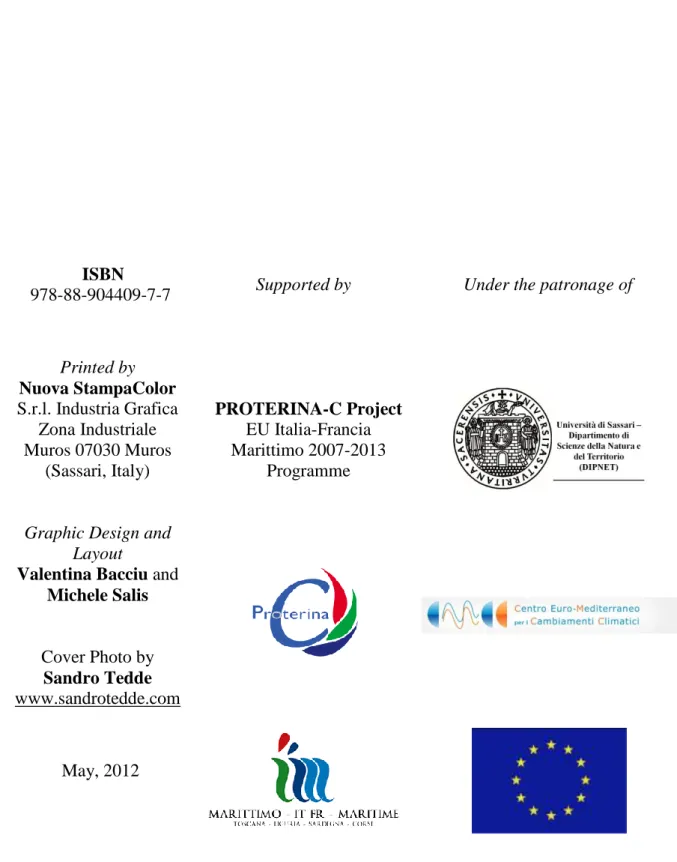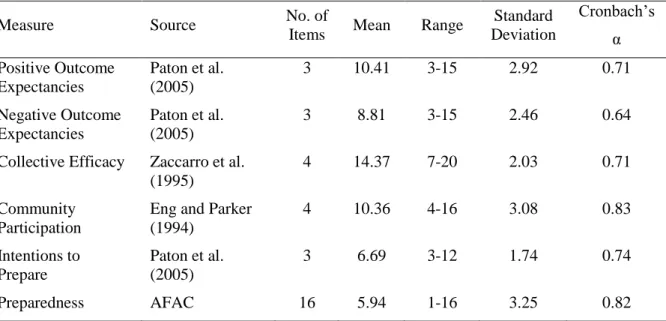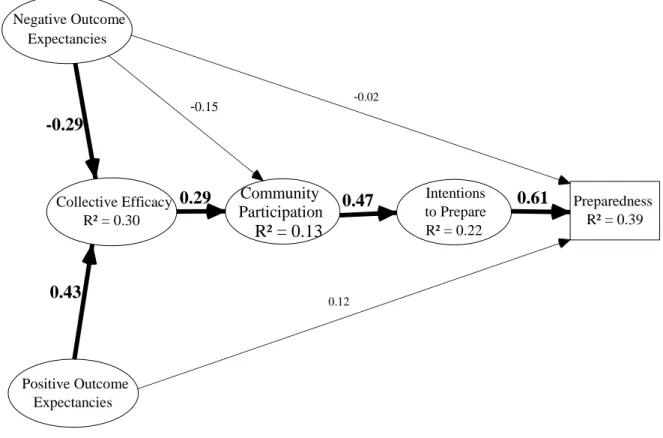Modelling
Fire
Behaviour
and Risk
Eds. Donatella Spano,
Valentina Bacciu,
Michele Salis,
Costantino Sirca
Supported by PROTERINA-C
Project EU Italia-Francia Marittimo
2007-2013 Programme
Modelling Fire Behaviour and Risk
Supported by PROTERINA-C Project:
A forecast and prevention system for climate change impacts
on risk variability for wildlands and urban areas
(EU Italia-Francia Marittimo
2007-2013 Programme)
Editors
Donatella
Spano
Valentina
Bacciu
Michele
Salis
Costantino
Sirca
Department of Science for Nature and Environmental Resources (DipNeT), University of Sassari, Italy;
Euro-Mediterranean Center for Climate Changes (CMCC), IAFENT Division, Sassari, Italy
ISBN
978-88-904409-7-7 Supported by Under the patronage of
Printed by Nuova StampaColor S.r.l. Industria Grafica Zona Industriale Muros 07030 Muros (Sassari, Italy) PROTERINA-C Project EU Italia-Francia Marittimo 2007-2013 Programme
Graphic Design and Layout
Valentina Bacciu and Michele Salis
Cover Photo by
Sandro Tedde
www.sandrotedde.com
Fires and Wildland Urban Interfaces
224
Enhancing forest fires preparedness in Portugal: the relevance
of integrating risk communication with community engagement
and development
Paton D.1, Tedim F.21
School of Psychology, University of Tasmania, Launceston, Tasmania, Australia; 2Faculty of Arts, University of Porto, Via Panorâmica s/nº, 4150-564- Porto, Portugal
Douglas.Paton@utas.edu.au
________________________________________________________________________ Abstract
The growing incidence, size, intensity and duration of forest fires and escalating economic constraints has made reliance on fire suppression activities as the main fire management strategies in Portugal less tenable. Recognition of this led fire and municipal civil protection agencies to include community preparedness in comprehensive risk management planning. Because this is a new element of risk management in Portugal, agencies need information on cost effective approaches to facilitate community preparedness. Using data from a study of forest fire preparedness in Portugal, this chapter discusses the development and testing of a model of forest fire preparedness. Data from 197 residents from several communities in northern Portugal were used to test the model. Analysis confirmed that people‘s beliefs about the effectiveness of preparing (outcome effectiveness) interacted with social processes and competencies (community participation, collective efficacy) to explain differences in levels of forest fire preparedness. Because the social processes and competencies identified derived from people‘s life and community experiences, the findings highlight the importance of integrating risk communication with community engagement and development strategies if the goal of increasing preparedness is to be effectively pursued. Activities fire and municipal agencies can use to facilitate preparedness are discussed, as is the potential for using the model in Europe and Australia.
Keywords: Forest fire preparedness, risk communication, community engagement
1. INTRODUCTION
Forest fire incidence is very high in Portugal where, in 2010, were recorded half the fires and burnt area of all southern European countries (JRC 2011). Fire represents significant ecological, social and economic threats to many communities in Portugal. The traditional approach to managing forest fires focuses on suppression with a minor emphasis in mitigation (e.g., controlled burning). However, reliance on these strategies is becoming less tenable as a result of the growing number, intensity and duration of fires exceeding available fire fighting resources and economic pressures reducing fire fighting resources. This has led to recognition of a need for communities and fire agencies to work collectively to manage shared risk. If people prepare and develop strategies to defend their properties, fire agency resources can focus more on suppression activities and suppression is easier if fire fighters do have to defend homes. This can be done by increasing community involvement in planning and facilitating community preparedness in ways that increase people‘s capacity to prevent and respond to fire events.
Fires and Wildland Urban Interfaces
225
People can prepare by, for example, creating a defensible space around their property, using fire-resistant materials for renovation or building, safeguarding their house (e.g., ensuring roof tiles fit tightly to prevent embers entering through the roof, screening vents and eves with metal fly wire to prevent ember entry, and fitting shutters or metal screens to windows). Preparing reduces the risk of injury and death, facilitates people‘s capacity to cope with disruption, and helps them adapt to and recover from fire impacts. Well prepared people and homes also increase the likelihood of people being available to assist recovery efforts in their community, facilitate the maintenance of the social networks that assist social recover, and helps sustain the economic vitality of areas adversely affected by fire. Encouraging preparedness thus plays a significant role in risk management. The question is how to accomplish this task. The challenge of doing so is complicated by the fact that the move to including a community or social dimension introduces a significant point of departure in forest fire risk management planning in Portugal (Paton and Tedim 2012). To facilitate preparedness, agencies need to know how to develop the community resource. This chapter discusses research into identifying community predictors of preparedness. In so doing it provides agencies with guidelines for developing community preparedness within a risk management strategy designed to facilitate greater community involvement in local forest fire risk management. It discusses the development and testing of a model that identifies the predictors of forest fire preparedness in communities.
2. PREDICTING COMMUNITY PREPAREDNESS
The model is founded on recognition that peoples‘ perception of risk and how they might mitigate it is socially constructed (Paton and Bishop 1996; Earle 2004). This suggests that the ability of community members to interpret forest fire and prepare to manage their risk will be a function of the degree to which they possess the processes and competencies that help them to interpret their circumstances and take action to deal with novel issues facing the community. Processes and competencies that are relevant here are the degree of connectedness within a community that underpins the sense of social responsibility for managing risk, being actively engaged with others in ways that facilitates developing risk beliefs and discussing how to manage risk, and having experience of taking action to deal with issues that represent collective problems for a community. The model identified community participation and collective efficacy as variables that would capture these processes and competencies (Eng and Parker 1994; Zaccaro et al. 1995). These processes and competencies develop as a result of experiences community members accumulate over time. Once developed, they provide the foundation for how people, for example, determine what consequences they could face, work out what would be an effective response, and then consider what information and resources they require to enact their risk management strategies.
The theory introduced a need to examine whether people believe or expect that preparedness will lead to the outcome of increasing safety or preventing or reducing loss and damage (Paton 2008). The ‗outcome expectancy‘ construct describes this interpretive process. Negative outcome expectancy reflects a belief that forest fire consequences are too catastrophic for personal action to make any difference to peoples‘ safety. If people hold this belief, they are less likely to prepare. In contrast, if people hold positive outcome expectancy beliefs, they believe that a measure will increase personal safety and protect the home. If people hold positive outcome expectancy beliefs, preparation will be mediated by
Fires and Wildland Urban Interfaces
226
the social processes (collective efficacy, community participation) used to articulate community members needs and expectations. This chapter discusses the findings of a study applying this theory to forest fire preparedness in Portugal.
3. TESTING THE MODEL
Data were collected from communities in northern Portugal that experience a high frequency of forest fires. The Municipalities in which the questionnaires were distributed were: Arcos de Valdevez, Baião, Cinfães, Melgaço, Mirandela, Montalegre, Ponte da Barca, Terras de Bouro, and Vieira do Minho. Data from 197 respondents were collected. The items included in the questionnaire are listed in Table 1. Because it allows the assessment of multiple and inter-related relationships between variables simultaneously, structural equation modelling (SEM) was used for the analysis. Screening and assessment of data confirmed that the data were suitable for SEM analysis. The means and standard deviations are listed in Table 1.
Table 1. Variables used and descriptive statistics
Measure Source No. of
Items Mean Range
Standard Deviation Cronbach‘s α Positive Outcome Expectancies Paton et al. (2005) 3 10.41 3-15 2.92 0.71 Negative Outcome Expectancies Paton et al. (2005) 3 8.81 3-15 2.46 0.64
Collective Efficacy Zaccarro et al. (1995)
4 14.37 7-20 2.03 0.71
Community Participation
Eng and Parker (1994) 4 10.36 4-16 3.08 0.83 Intentions to Prepare Paton et al. (2005) 3 6.69 3-12 1.74 0.74 Preparedness AFAC 16 5.94 1-16 3.25 0.82
Confirmatory factor analysis indicated that the measurement variables significantly represented their respective latent variables. This provided the basis for testing the structural model (Figure 1). The hypothesised structural model was evaluated using the maximum likelihood method of estimation. Each latent variable was allowed to covary in order to represent unanalysed associations, and each indicator loaded on only one latent variable (Kline 2005) to test whether the proposed model was a good fit to the data.
Multiple fit indices were inspected. The likelihood-ratio chi-square (χ 2) statistic is the primary measure of fit. Non-significant differences indicate a good fit of the model to the data. Because of the sensitivity of the chi squared statistic to sample size, Hu and Bentler (1999) recommend using the chi-square/df ratio (CMIN/DF). CMIN/DF ratios close to one suggest a very good model fit, while values < 2 indicate a good fit (Hu and Bentler 1999). The Root Mean Square Error of Approximation (RMSEA) assesses the amount of error present in the fit and is considered to produce accurate assumptions about model quality
Fires and Wildland Urban Interfaces
227
(Kline 2005). Values that are < 0.05 suggest a good fit to the data, while values between 0.05-0.08 reflect an adequate fit. The Goodness-of-Fit Index (GFI), Normed Fit Index (NFI), Tucker-Lewis Index (TLI), Incremental Fit Index (IFI), and Comparative Fit Index (CLI) all approximate the degree to which the theoretical model is superior to the null or independence model. They range from 0 (no fit to the data; a fit that does not improve on the null model) to 1 (perfect fit to the data) and values greater than 0.90 are considered to reflect an adequate fit to the data.
Figure 1. A summary of SEM analysis
The analysis demonstrated that the model was a good fit to the data, (χ2
(123, N = 197) = 143.80, p = 0.10, CMIN/DF = 1.17, RMSEA = 0.03, 90% 0.000.05, NFI = 0.87, TLI = 0.97, IFI = 0.98, CFI = 0.98, PCLOSE = 0.97). Significant relationships are in bold. Overall, levels of forest fire preparedness were low. The average number of house protection measures adopted was 6 (of 16). The model accounted for 39% of the variance in levels of forest fire preparation. This confers upon these findings a good/moderate effect size (Sheeran 2002), supporting the use of the model as a guide for developing risk communication strategies to facilitate forest fire preparedness.
4. DISCUSSION
The analysis confirmed that personal beliefs regarding the efficacy of preparedness interacted with social characteristics (community participation) and competencies (collective efficacy) to help explain differences in levels of forest fire preparedness in
Preparedness R² = 0.39 Collective Efficacy R² = 0.30 Community Participation R² = 0.13 Intentions to Prepare R² = 0.22 0.61 Positive Outcome Expectancies Negative Outcome Expectancies 0.12 -0.02 -0.15 0.29 0.47 -0.29 0.43
Fires and Wildland Urban Interfaces
228
Portuguese communities. As predicted, negative outcome expectancy reduced the likelihood of people preparing (Figure 1).
The analysis demonstrates how preparedness results not just from providing information and resources but also from ensuring that people can make sense of and use information and resources to meet their needs. It follows that, from a risk management perspective, an effective public education strategy must work with and engage with the community. In this context, it is important to note that the social context factors that predicted the adoption of forest fire protective measures were pre-existing community characteristics (e.g., participation) and competencies (e.g., collective efficacy) that derived from people‘s engagement in daily community activities over time.
This suggests that the effectiveness of risk management strategies can be increased by integrating them with mainstream community development strategies (Paton 2008; Pearce 2003). Thus community engagement strategies must assess and if necessary develop and encourage use of social networks (e.g., active participation) within which people can develop appropriate risk beliefs; the competencies (e.g., collective efficacy, planning) that help people identify ways to respond and that help people identify how to put strategies into action.
This work identified a need for community outreach strategies to increase preparedness. This need was indicated by finding that, on average, only 6 or 16 preparedness measures were undertaken. In particular, current preparedness activities are problematic as people were least likely to adopt the structural (e.g., defensible space, house protection) and planning (e.g., household fire response plan) activities that will make the greatest impact on helping fire agencies focus on suppression activities. If people do not adopt structural protection (e.g., defensible space), they and their properties remain more at risk and will require fire agencies to divert more suppression resources to protecting homes. If people adopt structural measures, agencies and communities can actively complement one another in an integrated risk management strategy.
Strategies to promote preparedness should focus on influencing outcome expectancy beliefs and the use of social processes to facilitate preparedness (Paton and Wright 2008). Negative outcome expectancy arises because people assume that forest fires are too catastrophic for personal actions to be effective. Such beliefs could be countered by presenting images that compare properties close to each other where one is damaged by fire and the other not to illustrate how actions can affect damage. This approach can be supplemented by clearly differentiating the fact that while people cannot control forest fire they can control its consequences (e.g., a defensible space reduces threat from embers and protects property) and emphasising the need to focus on consequences.
Preparedness can be facilitates by getting people to personalize impacts (e.g., asking them to consider what a fire might mean for them and their community) and by arranging discussions with people from communities that have prepared and who can talk about its effectiveness. Information should focus on explaining how fire affects properties and how specific actions prevent loss (e.g., see example above). Information is most effective when it deals with specific topics (e.g., discuss embers, their causes, and how to protect from them) rather than covering everything at one time and when people discuss how to use this information. This can be facilitated through organising social meeting that include property assessments and showing what an effectively prepared property looks like. Workshops, consultative liaison committees, public forums can be used to promote discussions and
Fires and Wildland Urban Interfaces
229
identify new ideas and issues from within the community. This work may have applicability beyond Portugal. Consistency between this study and a research in Australia suggests that the model of forest fire preparedness developed here has cross-culturally applicability and can be used throughout Europe and Australia.
5. CONCLUSION
This chapter identified a need to accommodate personal beliefs and social processes in strategies to facilitate forest fire preparedness. The analysis suggested that this can be cost effectively by integrating risk management with community development initiatives. This fosters social capital and will result in enduring benefits for communities and not just in the context of their experiencing forest fires. This increases the cost effectiveness of this aspect of risk management, an important and pragmatic consideration at a time when financial constraints need to be accommodated in risk management planning.
The authors would like to acknowledge and thank the Portuguese Science Foundation (FCT-Fundação para a Ciência e a Tecnologia) for supporting the research under the project PTDC/GEO/65344/2006.
6. REFERENCES
Earle T., 2004. Thinking aloud about trust: A protocol analysis of trust in risk management. Risk Analysis, 24(1), 169-183.
Eng E., Parker E., 1994. Measuring community competence in the Mississippi Delta: The
interface between program evaluation and empowerment. Health Education Quarterly,
21, 199-220.
Hu L., Bentler P.M., 1999. Cutoff criteria for fit indexes in covariance structure analysis:
Conventional criteria versus new alternatives. Structural Equation Modeling 6(1), 1-55.
JRC, 2011. Forest Fires in Europe 2010. Luxembourg: Publications Office of the European Union.
Kline R.B., 2005. Principles and Practice of Structural Equation Modeling (2nd ed.) New York: The Guilford Press.
Paton D., 2008. Risk communication and natural hazard mitigation: How trust influences
its effectiveness. International Journal of Global Environmental Issues, 8(1/2), 2-16.
Paton D., Bishop B., 1996. Disasters and communities: Promoting psychosocial well-being. In D. Paton and N. Long (Eds.), Psychological Aspects of Disaster: Impact, Coping,
and Intervention (pp. 255-268). Palmerston North, New Zealand: Dunmore Press.
Paton, D., Smith L.M., Johnston D. 2005. When good intentions turn bad: Promoting
hazard preparedness. Australian Journal of Emergency Management, 20(3), 25-30.
Paton D., Tedim F., 2012. A Dimensão Social dos Incêndios Florestais. Identificação de factores que contribuem para uma gestão sustentada e integrada. In F. Tedim and D. Paton (Eds.), A Dimensão Social dos Incêndios Florestais. Contributo para uma gestão
integrada e sustentável, Porto, Portugal: Estratégias Criativas.
Paton D., Wright L., 2008. Preparing for Bushfires: The public education challenges facing fire agencies. In J. Handmer and K. Haynes (Eds.), Community Bushfire Safety. Canberra: CSIRO Publishing.
Fires and Wildland Urban Interfaces
230
Pearce L., 2003. Disaster Management and Community Planning, and Public
Participation: How to Achieve Sustainable Hazard Mitigation. Natural Hazards, 28,
211-222.
Sheeran P., 2002. Intention-behaviour relations: A conceptual and empirical review. In W. Stroebe and M. Hewstone (Eds.). European review of social psychology (pp. 1–36). Chichester, United Kingdom: Wiley.
Zaccaro S.J., Blair V., Peterson C., Zazanis M., 1995. Collective efficacy. In J.E. Maddux, (Ed.), Self efficacy, adaptation, and adjustment: Theory, research, and application (pp. 305-328). New York: Plenum Press.


